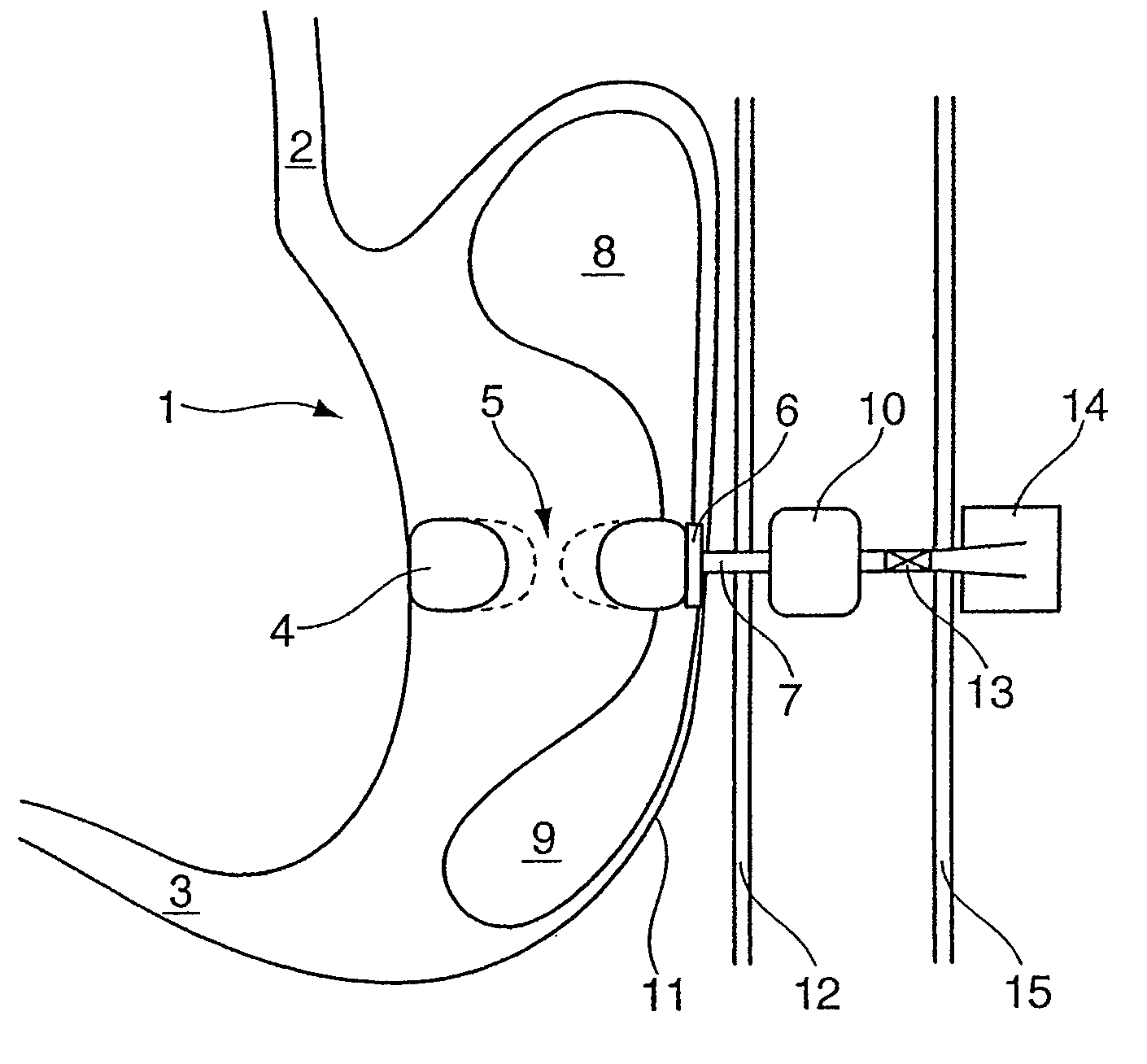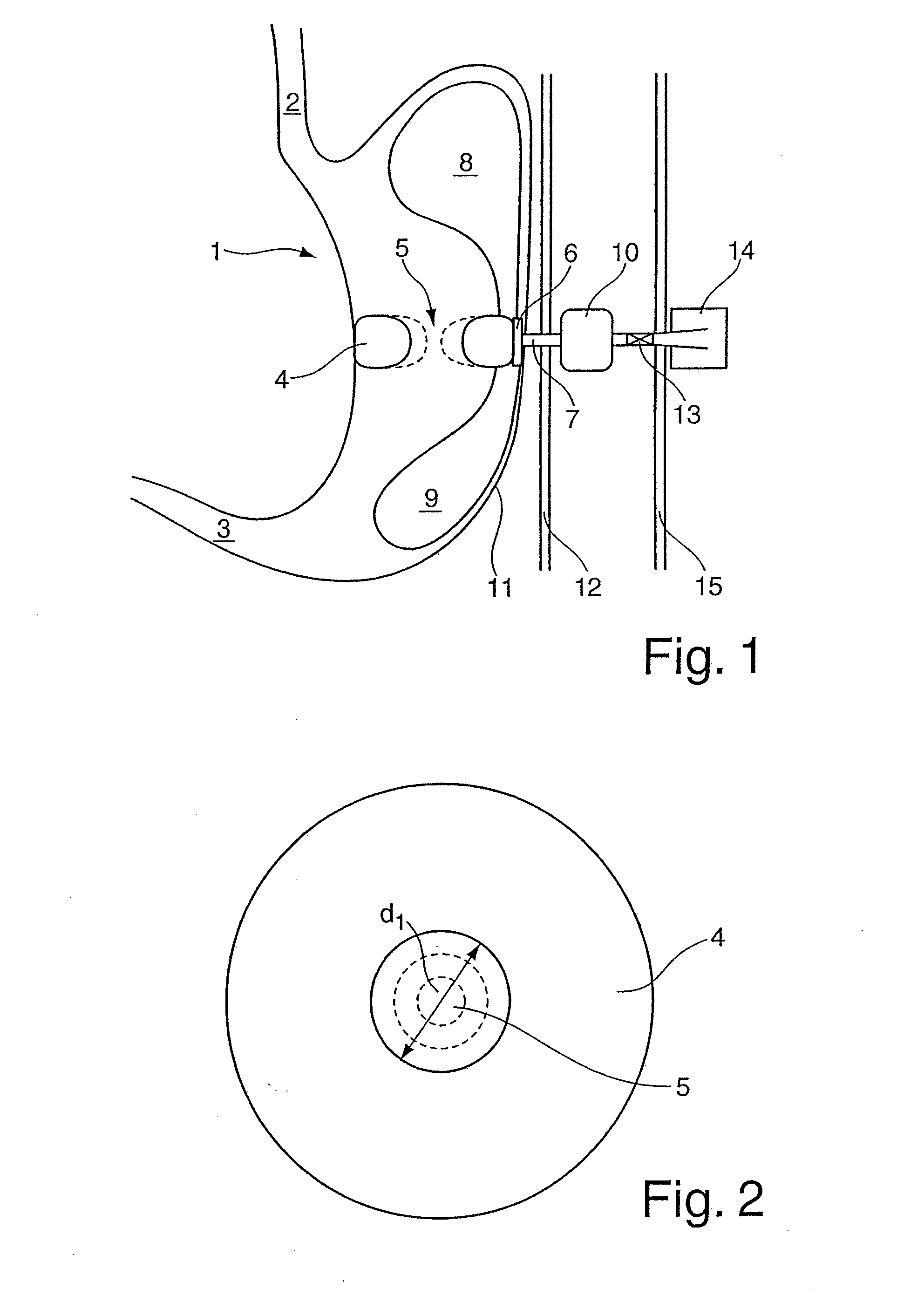[0019]The invention is based on development of a device according to the above-cited U.S. Pat. No. 6,454,785 B2 for treating obesity in humans, with a balloon arrangement that can be introduced into the
human stomach and that can be filled with a fluid and emptied inside the stomach for controlled reduction of the stomach volume in such a manner that a stimulation of the stomach for producing a feeling of satiation is dispensed more finely and brought about more quickly, without straining the stomach by excessive dilation of the gastric balloon in the process. The device should offer the patient in the most gentle possible manner the opportunity to learn
healthy eating behavior without being restricted in
everyday activities. In order to remove the device from the stomach, the device should not affect stomach-intestine continuity. Finally, the existing great demand for the device to be offered as cost-effectively as possible ensures that the measure can be used as extensively as possible.
[0022]In contrast to the previously known gastric balloon systems, the balloon arrangement according to the invention includes the combination of at least two means which can be filled with a fluid and have different tasks to perform according to their shape and positioning inside the stomach after being correspondingly introduced into the stomach. The second means, which in the filled state assumes a ring-shaped or loop-shaped configuration, is formed in shape and size in such a manner that the outer contour of the second means in the filled state bears with slight pressure against the inner wall of the stomach along a cross-
sectional plane through the body of the stomach, so that the stomach volume is divided by the ring-shaped or loop-shaped second means into an upper and lower stomach region, with the oesophagus opening into the upper stomach region and the lower stomach region being connected at its exit with the
duodenum. The upper and lower stomach regions are only connected fluidically by the clear internal
diameter which is radially enclosed by the second means in the filled state, the clear opening width of which internal
diameter can be varied by the filling level of the second means. In this manner it is possible to use the filling level of the second means to control the stomach
throughput and even completely suppress it when the second ring-shaped or loop-shaped means is completely filled.
[0030]To
implant the device according to the invention, it is assumed below that the balloon arrangement has three means which are connected fluidically to each other and can be filled with a gaseous or liquid fluid via a fluid line. The fluid line is, as described above, preferably attached in a fluid-tight manner to the ring-shaped or loop-shaped means by means of a corresponding holding element and has along its proximal extent a fixing element which is configured as an
inflatable body and at least one valve unit which is preferably configured as a
ball valve. The device according to the invention is implanted in the stomach by means of
percutaneous endoscopic
gastrostomy (PEG) through the oesophagus, with an auxiliary
catheter which is introduced into the stomach transcutaneously by means of transgastric puncture being used for the implantation along the oesophagus. Such an implantation method has been standard in
medicine for a long time and is associated with only low complication rates of 0.3 to 1% and thus entails a considerably
lower risk to the patient than all the other above-mentioned
surgical methods. It is possible using the proximal end, which is brought out extracorporally transcutaneously by means of the auxiliary
catheter, of the fluid line to align the triple-lumen balloon arrangement, which is introduced inside the stomach, and then fix it to the musculature of the
abdominal wall. Using the holding element, for example in the form of a holding plate, which is attached to the ring-shaped or loop-shaped second means, it is possible to place the balloon arrangement inside the stomach in the above-described manner. The correct placement of the balloon arrangement within the stomach can be checked with the aid of diagnostic techniques which are known per se, such as x-
ray or magnetic technologies. To this end, it is advantageous to provide at least the holding element with a detectable
platelet of suitable material.
[0033]The device according to the invention enables an unhindered application without restriction in the movement behavior of the patient. It can be used particularly advantageously for
long term treatments for learning
healthy eating habits and moreover allows learned
eating behavior to be checked by reducing the filling level of the individual balloon-like lumens in a controlled manner and allowing the stomach to assume the task of
natural food utilization largely without artificial stimulation by the balloon arrangement. If it is established that the taught
eating behavior has not been sufficiently put into practice, the individual lumens of the balloon arrangement can be suitably filled again.
[0034]If the treatment has led to a considerable reduction of the
excess weight as desired and the patient is able to keep his or her weight constant over a long period with an empty balloon arrangement, it is furthermore possible to remove the balloon arrangement according to the solution extracorporally without any problems. To this end, the balloon arrangement is completely emptied, the fluid tube is
cut endogastrically just above the holding plate or holding element and endoscopically extracted with a customary endoscopic loop. The remaining fluid tube is pulled out of the
subcutaneous tissue by the closing cap. The above measures can be carried out in a minimally invasive manner, with the stomach-intestine continuity being unrestrictedly maintained.
[0035]The device according to the invention allows extensive application in all industrialized nations by using the PEG method which is known per se and standardized so that it can be expected that there is a high acceptance potential among persons involved in the treatment of adiposis owing to largely negligible risks.
 Login to View More
Login to View More  Login to View More
Login to View More 

